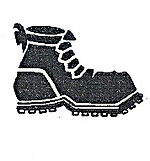7th Mountain Division (Wehrmacht)
|
7th Mountain Division |
|
|---|---|
 Troop registration: The mountain boot |
|
| active | November 16, 1940 (as 99th Light Infantry Division ) Reclassification: October 22, 1941 to May 8, 1945 (surrender) |
| Country |
|
| Armed forces | Wehrmacht |
| Armed forces | army |
| Branch of service | Mountain troop |
| Type | Mountain Division |
| structure | structure |
| Installation site | Bad Kissingen |
| Nickname | Mountain shoe division |
| Second World War | War against the Soviet Union |
| Commanders | |
| list | Commanders |
| insignia | |
| Troop registration | White mountaineering boots in red heraldic shield |
The 7th Mountain Division was a large unit of the mountain troops of the Wehrmacht in World War II .
history
The division was set up on November 15, 1940 in Bad Kissingen as the 99th light infantry division. As such, they took as part of the 6th Army at war against the Soviet Union in part and moved into their association Kiev before. In August 1941 it was moved to the Grafenwöhr military training area , where it was reclassified to the 7th Mountain Division by October 22, 1941.
Parts of the division were relocated as "Gruppe Hoffmeister" in March 1942 to the northern section of the Eastern Front on the Ilmensee and subordinated to the "Shock Group Seydlitz" during the attack and defensive battles in the Koslowa-Kudrowa area, on Redzy-Weg and Gridino-Weg. The remaining parts of the division were relocated to Finland as the “Krakau Group” - named after the division commander - and involved in attack and defensive battles in the Uhtua area .
In July / August 1942 the "Hoffmeister group" was relocated to Finland in the Kiestinki section and merged there with the other parts of the division, which was then replaced by the Finnish J division.
Defensive battles followed in northern Finland against superior Soviet forces. When Finland broke off diplomatic relations on September 2, 1944 and finally signed an armistice agreement with the Soviet Union on September 19, 1944 , a difficult situation arose for the German troops. The Finns had undertaken to disarm the German troops and hand them over to the Soviet Union as prisoners. As a result, fights developed between their own troops and their former allies, which were supposed to prevent the Germans from retreating to Norway (see also the Lapland War ).
From October 1944, as part of the 20th Mountain Army , the division fought off Soviet attacks in the " ram position " in the triangle between Norway, Finland and Sweden . From January 1945 a withdrawal movement began first in the Narvik area and then to southern Norway, where it surrendered to the British in the Lillehammer area .
Commanders
99th Light Infantry Division
- Lieutenant General Kurt von der Chevallerie - from December 10, 1940
7th Mountain Division
- Lieutenant General Rudolf Konrad - Listed until December 19, 1941
- Major General Wilhelm Weiss - December 19, 1941 to January 1, 1942
- Lieutenant General Robert Martinek - January 1 to June 1942
- Colonel August Krakow - May 1 to July 22, 1942 (in charge of deputy leadership)
- Lieutenant General Robert Martinek - July 22 to September 10, 1942
- Lieutenant General August Krakow - September 10, 1942 until surrender
structure
| 99th Light Infantry Division | 7th Mountain Division |
|---|---|
|
|
The Infantry Replacement Battalion 21 in Fürth was responsible for providing replacement staff until June 1943 , followed by the Gebirgsjäger Replacement Battalion 319 in Coburg .
Well-known members of the division
- Zdenko Paumgartten (1903–1984), was from 1961 to 1968, as General of the Infantry of the Federal Army , Commander of Group III
- Otto Seitz (1911–1974) was in 1970, as General of the Infantry of the Federal Army, Head of Section III in the Federal Ministry for National Defense
literature
- Roland Kaltenegger : The path of fate and struggle of the "Bergschuh" division: the war history of the 7th Mountain Division, formerly the 99th Light Infantry Division . Stocker , Graz / Stuttgart 1985, ISBN 3-7020-0499-8 .
- Georg Tessin : Associations and troops of the German Wehrmacht and Waffen SS in World War II 1939–1945. Volume 3: The Land Forces 6-14 . 2nd Edition. Biblio-Verlag, Bissendorf 1974, ISBN 3-7648-0942-6 .
- Georg Tessin : Associations and troops of the German Wehrmacht and Waffen SS in World War II 1939–1945. Volume 6. The Land Forces 71-130 . 2nd Edition. Biblio-Verlag, Bissendorf 1979, ISBN 3-7648-1172-2 .
Web links
- Organizational History of the German Mountain and Ski Division 1939-1945 Nafziger Collection, Combined Armed Research Library.
- Literature on the 7th Mountain Division in the catalog of the German National Library
- Stock overview of the Federal Archives
Individual evidence
- ^ Organizational History of the German Mountain and Ski Division 1939–1945. (PDF, 90 kB) 7th Mountain Division. (No longer available online.) Archived from the original on December 8, 2011 ; accessed on September 16, 2011 .
